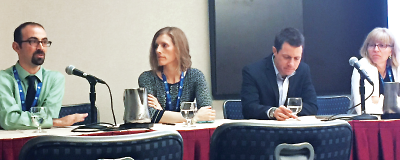What Role Can Technology Play in Assertive Community Treatment?
Abstract
Workshop panelists explore how simple electronic tools such as registries or web-based data resources can improve how patients and providers track progress and important outcomes.
At APA’s fall meeting, IPS: The Mental Health Services Conference, Erik Vanderlip, M.D., M.P.H., likened programs of assertive community treatment (PACT) to Tom Selleck’s Ferrari in Magnum P.I.

Anthony Battista, M.D., M.P.H., says that web-based patient resources that track and display health statistics can improve the efficiency of assertive community treatment programs. At right are Heather Larsen, M.D., Erik Vanderlip, M.D., M.P.H., and Nancy Williams, M.D.
“In the 1980s, everyone wanted to drive that Ferrari; it was fun, and fast, and sexy,” Vanderlip said in the workshop titled “PACT to the Future: How Using Technology Can Enhance PACT Services and Outcomes.”
“It’s still an awesome car today,” continued Vanderlip, an assistant professor of psychiatry and medical informatics at the University of Oklahoma School of Community Medicine. “But in 2016 we have Teslas, which are also fun and fast but are more efficient and can fit my whole family.”
Much like Magnum’s car, he said, assertive community treatment—a team-based model of care that provides comprehensive services to people with serious mental illness who live independently—has long been the Ferrari of interventions aimed at helping people with severe mental illness recover and have productive lives.
“[PACT] is still relevant today; other aspects of medicine are just now employing strategies that PACT teams have known for years,” Vanderlip said. “But this doesn’t mean that PACT can’t embrace new technology to make it more efficient.”
He pointed out technology does not have to mean cutting-edge tools or devices. For instance, data from computer registries can be displayed in something as basic as an Excel spreadsheet and used by a PACT team to visualize that data and keep track of outcomes.
He noted that making registries overly complex would defeat the purpose of efficiency as staff would spend inordinate time inputting data; however, including a few simple and measurable traits, such as glucose levels or body weight, could help the entire PACT team monitor a patient’s progress.
Visualization and progress tracking are also the concepts behind web-based decision-making tools such as CommonGround, noted Anthony Battista, M.D., M.P.H., a community psychiatrist at Eliot Community Health Services in Lynn, Massachusetts. An overabundance of bells and whistles are not needed.
When patients come in for monthly health visits, their information gets entered into a database that can be accessed by patients in graph format so they can see how certain characteristics, such as sleep behaviors or mood, change each month. The health care staff can also make use of the graphs to see how behaviors track with medication usage to see if progress is being made.
Another feature of this shared resource is a library of over 200 short videos of people at various stages in the recovery process that a patient can use to help to think about or set goals.
“For example, if a patient wants to quit smoking, there are many videos of other patients describing their experiences,” Battista said. “And since they are patient peers, an individual can relate to what they are watching.”
He added that by using CommonGround—both at home and at the clinic—patients have the opportunity to put technology into practice, which, in turn, can help to improve the computer literacy of patients in addition to their mental health.
“Incorporating a tool like CommonGround does require a large investment from an IT department, and a team needs some champions of technology to get everyone to buy in, but the benefits can be significant,” said presenter Hannah Larsen, M.D., also of the Eliot Health Services. During her talk, she described several ways such tools can be implemented at a community health center.
“It’s important that clinics not think of new technologies as something they are forced to do, but rather a tool that’s been given to you to help make the job better,” she said.
Nancy Williams, M.D., a clinical professor of psychiatry at the University of Iowa Carver School of Medicine and medical director of Iowa’s PACT program, IMPACT, concluded the workshop by discussing the ways telepsychiatry may be used to advance PACT.
She noted that there is very little literature on telepsychiatry in PACT and that only a handful of states have been using this approach in practice, incorporating telepsychiatry into one or two PACT teams to explore its value. However, some data available from states such as Minnesota and Delaware that have been experimenting with PACT telepsychiatry point to this resource being roughly equivalent in cost and efficiency to traditional models.
The topic of PACT telepsychiatry was met with skepticism by several workshop attendees, who stressed that the core of any successful PACT program is relationships, not only between the doctor and patient, but also the doctor and the rest of the staff. Some audience members wondered whether these strong connections could be recreated using a virtual space.
One community psychiatrist in the audience described how his visits to patients often entail observing both the patient and dwelling. Trying to survey a home through the eyes of a camera might miss important details, he said.
Williams said that while telepsychiatry may benefit regions where there is a shortage of PACT workers—particularly in rural areas—it will take time before the impact of telepsychiatry on the relationship between patients and PACT teams is clear. ■



